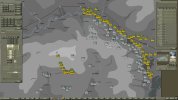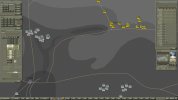Assuming the addition of the cupola allowed Soviet tanks to spot potential targets, since you've already addressed differences in crew capabilities based on training and experience, you may be able to emulate visibility constraints from vehicles by adjusting the "practical rate of fire" for weapons installed on that vehicle.
Spotting, well, optics (telescopes) were used to spot, identify, observe and engage enemy tanks in the distance, persicopes were used to grasp the terrain layout , to improve the situational awareness and to gather a quick overview of enemy and friendly movement on the perimeter. Most periscopes offered very low levels of magnification only, some had even 0 magnification.
Especially with the 0-level periscopes, Cupolas helped to easily maintain/up situational awareness at close range, maybe even up to lower medium ranges. The cupola gave a commander the opportunity to quickly scan the surrounding area, the several solutions either offered an almost 360-degrees view (eg. German cupolas had 5 bullet-proof glass "bricks", so there were small vertical gaps in the view, 8-9 bricks became standard in later cupola versions/tank models) in the most advanced cupolas, or - without cupola - even a full 360 view:
British A15 cruiser tanks had a revolutionary angled mirror on top/the center of the turret roof which could be rotated 360°, and where a fixed iron sight right above the gun mantlet could be used by the commander to give specific orders to the gunner where to aim horizontally. With that iron sight, the commander could assess within one 1 second, whether the gunner aimed at the right direction/tank, or not. Downside: the FOV was pretty limited, the periscope in the Sherman had a FOV of 12 degrees only, iirc, even in the late war dual optics versions (telescope and periscope in one case/device).
In chaotic close combat situations, eg. in Russia, German tank commanders could easily follow Russian tanks trying to get around their tanks or trying to ram their tanks, as the cupolas offered complete overviews. The cupola on the Matilda was put on a ball-bearing ring, a very clever idea, the downside was that it had to be rotated like the cruiser mirror, as it had a limited view port only (afaik), as well. Cupolas were also used to observe flanking/approaching infantry units, ofc. Panzer III tank cupolas received an iron sight similar to the idea behind the British cruiser tank's iron sight, possibly in 1940 or 1941, it was attached to the cupola and fixed as well, at least.
The Panzer III had another revolutionary system, the "clock indicator": When the turret rotated, the turret ring's coqs moved a prop shaft which drove/moved the commander's indicator arrow pointer. The indicator's 12 o'clock always aligned with the 12 o'clock position/front tip of the chassis.
So, when the commander spotted an enemy say at the tank hull's 9 o'clock, he would just call out "enemy tank at 9 o'clock, engage" on the intercom and the gunner, who had the same indicator, would either turn the turret instantly, or - if there was enough time - he would wait for the driver to turn the tank. The driver didn't have such indicator in the Panzer III and IV, afaik, but there are pictures of the Tiger I's driver position showing a scale to the driver's left, so I wouldn't rule out that Tiger I drivers had an indicator, too. Usually, in most German tanks (III to Panther) the gunner would use his foot and "kick" the driver in the left or right side to indicate that he had to turn the tank in the corresponding direction, IIRC.
In his memoirs, Tank Ace Otto Carius expressed that he despised Commanders who would button up when the battle started, and regarded them as second rate, if not totally useless. His approach was to keep the Commander's hatch open as long as possible and peek out, specifically to see the muzzle flashes of well camouflaged AT guns, as a round would usually hit the tank before the sound of the gun's shot could be heard. If a commander then didn't see the gun's flash, then the source/direction of the sound could still be located halfway that way, at least. He described situations where he looked slighty to the left, while an enemy AT gun's muzzle flash on the right would pop up in the corner of his eye. He then ordered to engage the target before the gun shot could be even heard and tried to engage the gun before its next round would hit his tank. He stressed that not relying on the cupola helped to save vital seconds which then often saved the tank/crew, while emphasizing that many tank commanders had been killed or injured that way, as many commanders used this method of screening the battlefield. He maintained that this method upped the tanks' chances of survival dramatically, usually, while - admittedly - creating a high(er) death count among tank commanders.
That said, a(n almost) 360-degrees cupola (besides offering protection to the commander) gave a definite advantage in CQBs if compared to tanks without cupola, but it reduced a commander's situational awareness at lower medium ranges and above, where commanders could easily spot things with their binoculars. Pictures suggest that some commanders even used v-shaped scissor scopes for safety, but also for long distance shots (for range finding), where curved trajectories had to be used. With the introduction of the cupolas in the T-34s, their commanders received some relief in their rather overstrained roles, with the combo commander/gunner and with suffering of a rather confined field of view/bad situational awareness in a cramped crew compartment, at least.
With today's electronic EQ, like IR-sight, targeting computers and scanners, cupolas are usually used to observe (enemy/friendly) infantry or vehicle movement in the tank's immediate vicinity, only, these days.
A crew that can't spot a target won't expend ammunition at the optimum combat rate of fire for the weapon.
A tank that couldn't spot a target usually had a short life span (not necessarily the crews, Allied statistics indicate that at least Western Allied tankers suffered of a high number of casualties in some battles, but their death ratios were surprisingly "low", which means that many tankers could often escape death, many of them with severe burns, lost arms/legs, shrapnel wounds etc., though). The management of training and replacing tankers must have been challenging for units using Shermans and suffering high casualty rates during/after particular engagements, at least.



